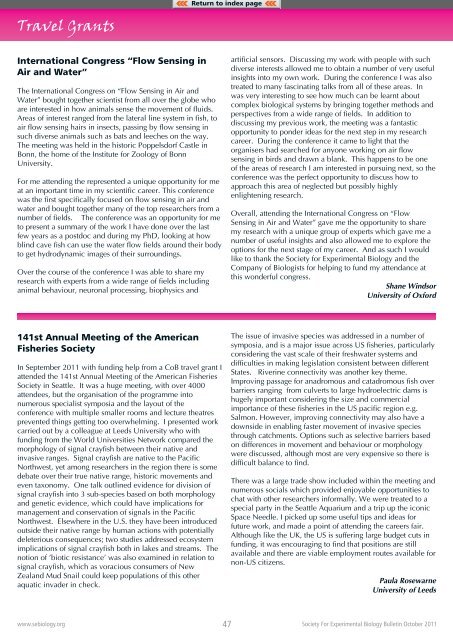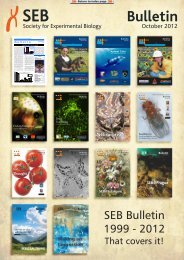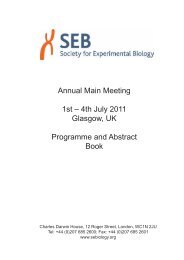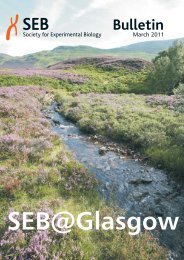SEB@SALZBURG - The Society for Experimental Biology
SEB@SALZBURG - The Society for Experimental Biology
SEB@SALZBURG - The Society for Experimental Biology
You also want an ePaper? Increase the reach of your titles
YUMPU automatically turns print PDFs into web optimized ePapers that Google loves.
Travel Grants<br />
International Congress “Flow Sensing in<br />
Air and Water”<br />
<strong>The</strong> International Congress on “Flow Sensing in Air and<br />
Water” bought together scientist from all over the globe who<br />
are interested in how animals sense the movement of fluids.<br />
Areas of interest ranged from the lateral line system in fish, to<br />
air flow sensing hairs in insects, passing by flow sensing in<br />
such diverse animals such as bats and leeches on the way.<br />
<strong>The</strong> meeting was held in the historic Poppelsdorf Castle in<br />
Bonn, the home of the Institute <strong>for</strong> Zoology of Bonn<br />
University.<br />
For me attending the represented a unique opportunity <strong>for</strong> me<br />
at an important time in my scientific career. This conference<br />
was the first specifically focused on flow sensing in air and<br />
water and bought together many of the top researchers from a<br />
number of fields. <strong>The</strong> conference was an opportunity <strong>for</strong> me<br />
to present a summary of the work I have done over the last<br />
few years as a postdoc and during my PhD, looking at how<br />
blind cave fish can use the water flow fields around their body<br />
to get hydrodynamic images of their surroundings.<br />
Over the course of the conference I was able to share my<br />
research with experts from a wide range of fields including<br />
animal behaviour, neuronal processing, biophysics and<br />
141st Annual Meeting of the American<br />
Fisheries <strong>Society</strong><br />
In September 2011 with funding help from a CoB travel grant I<br />
attended the 141st Annual Meeting of the American Fisheries<br />
<strong>Society</strong> in Seattle. It was a huge meeting, with over 4000<br />
attendees, but the organisation of the programme into<br />
numerous specialist symposia and the layout of the<br />
conference with multiple smaller rooms and lecture theatres<br />
prevented things getting too overwhelming. I presented work<br />
carried out by a colleague at Leeds University who with<br />
funding from the World Universities Network compared the<br />
morphology of signal crayfish between their native and<br />
invasive ranges. Signal crayfish are native to the Pacific<br />
Northwest, yet among researchers in the region there is some<br />
debate over their true native range, historic movements and<br />
even taxonomy. One talk outlined evidence <strong>for</strong> division of<br />
signal crayfish into 3 sub-species based on both morphology<br />
and genetic evidence, which could have implications <strong>for</strong><br />
management and conservation of signals in the Pacific<br />
Northwest. Elsewhere in the U.S. they have been introduced<br />
outside their native range by human actions with potentially<br />
deleterious consequences; two studies addressed ecosystem<br />
implications of signal crayfish both in lakes and streams. <strong>The</strong><br />
notion of 'biotic resistance' was also examined in relation to<br />
signal crayfish, which as voracious consumers of New<br />
Zealand Mud Snail could keep populations of this other<br />
aquatic invader in check.<br />
Return to index page<br />
artificial sensors. Discussing my work with people with such<br />
diverse interests allowed me to obtain a number of very useful<br />
insights into my own work. During the conference I was also<br />
treated to many fascinating talks from all of these areas. In<br />
was very interesting to see how much can be learnt about<br />
complex biological systems by bringing together methods and<br />
perspectives from a wide range of fields. In addition to<br />
discussing my previous work, the meeting was a fantastic<br />
opportunity to ponder ideas <strong>for</strong> the next step in my research<br />
career. During the conference it came to light that the<br />
organisers had searched <strong>for</strong> anyone working on air flow<br />
sensing in birds and drawn a blank. This happens to be one<br />
of the areas of research I am interested in pursuing next, so the<br />
conference was the perfect opportunity to discuss how to<br />
approach this area of neglected but possibly highly<br />
enlightening research.<br />
Overall, attending the International Congress on “Flow<br />
Sensing in Air and Water” gave me the opportunity to share<br />
my research with a unique group of experts which gave me a<br />
number of useful insights and also allowed me to explore the<br />
options <strong>for</strong> the next stage of my career. And as such I would<br />
like to thank the <strong>Society</strong> <strong>for</strong> <strong>Experimental</strong> <strong>Biology</strong> and the<br />
Company of Biologists <strong>for</strong> helping to fund my attendance at<br />
this wonderful congress.<br />
Shane Windsor<br />
University of Ox<strong>for</strong>d<br />
<strong>The</strong> issue of invasive species was addressed in a number of<br />
symposia, and is a major issue across US fisheries, particularly<br />
considering the vast scale of their freshwater systems and<br />
difficulties in making legislation consistent between different<br />
States. Riverine connectivity was another key theme.<br />
Improving passage <strong>for</strong> anadromous and catadromous fish over<br />
barriers ranging from culverts to large hydroelectric dams is<br />
hugely important considering the size and commercial<br />
importance of these fisheries in the US pacific region e.g.<br />
Salmon. However, improving connectivity may also have a<br />
downside in enabling faster movement of invasive species<br />
through catchments. Options such as selective barriers based<br />
on differences in movement and behaviour or morphology<br />
were discussed, although most are very expensive so there is<br />
difficult balance to find.<br />
<strong>The</strong>re was a large trade show included within the meeting and<br />
numerous socials which provided enjoyable opportunities to<br />
chat with other researchers in<strong>for</strong>mally. We were treated to a<br />
special party in the Seattle Aquarium and a trip up the iconic<br />
Space Needle. I picked up some useful tips and ideas <strong>for</strong><br />
future work, and made a point of attending the careers fair.<br />
Although like the UK, the US is suffering large budget cuts in<br />
funding, it was encouraging to find that positions are still<br />
available and there are viable employment routes available <strong>for</strong><br />
non-US citizens.<br />
Paula Rosewarne<br />
University of Leeds<br />
www.sebiology.org 47<br />
<strong>Society</strong> For <strong>Experimental</strong> <strong>Biology</strong> Bulletin October 2011





